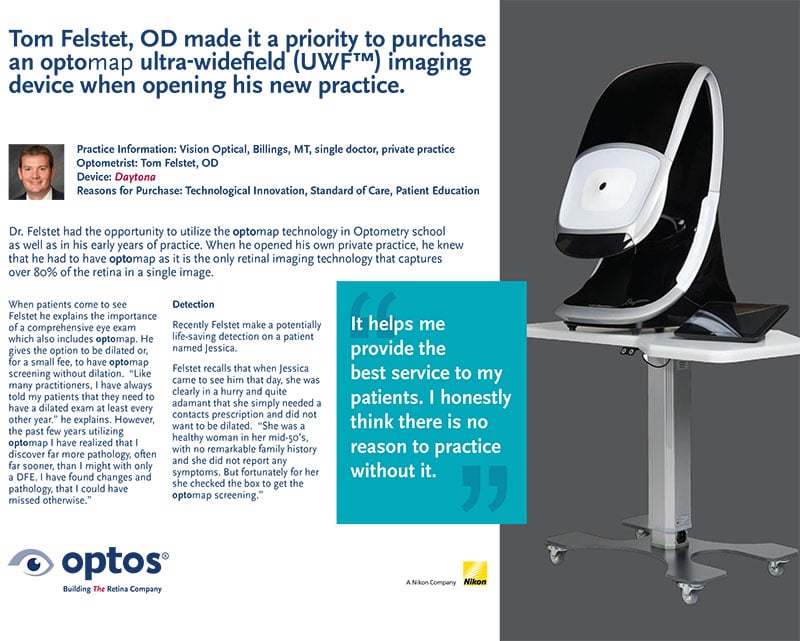Sponsored by Prevent Blindness, April is recognized as Women’s Eye Health and Safety Month. This observance is designed to educate women about the steps they can take to help stop vision loss.
April is deemed Women’s Eye and Safety Month to educate women about taking the proper steps today, to help preserve their vision in the future. “Healthy vision is something we often take for granted until it starts to slip away,” says Debbie Goss, president and CEO of Prevent Blindness. “We want to encourage women to put themselves on a path toward a lifetime of healthy vision by making an appointment for a comprehensive eye exam today!”
A comprehensive eye exam should include a thorough examination of the retina, including an optomap, which is complementary to a DFE and an excellent tool for screening and for patient education. Because an optomap image can be obtained in less than ½ second, it leaves ample time for the practitioner to educate on eye health.
Recent studies have shown that more women than men suffer from age-related macular degeneration, cataracts, glaucoma and diabetic retinopathy, the four leading eye diseases in the United States. Women are also at higher risk of developing sight-threatening autoimmune diseases such as multiple sclerosis, lupus and rheumatoid arthritis. Although some of these diseases have no known cure, many of the effects may be lessened through early detection and treatment. Recent surveys displayed alarming results in reference to women and eye exams. A Prevent Blindness survey found that:
- Less than 10% of American women realize that women are at a greater risk of suffering permanent vision loss than men
- 86% believe that men and women are at equal risk
- 5% believe that men are at greater risk
Dr. Tom Felstet and Jessica
Jessica, an actress, had just started rehearsing for a play in Billings, Montana, when she decided that contacts, rather than glasses, would better suit her part. “Really, I just thought it would be a good idea to be able to see while I was on stage, “she laughs. “That’s all I needed was to get fitted for contacts. I didn’t feel that I needed, nor did I have time for, an eye exam. ” However, as fate would have it, she went that day to see Dr. Tom Felstet, OD, who feels strongly that a thorough view of the retina should be a part of every eye exam.
Felstet recalls that when Jessica came to see him that day, she was clearly in a hurry and quite adamant that she simply needed a contacts prescription and did not want to be dilated. “She was a healthy woman in her mid-50’s, with no remarkable family history and she did not report any symptoms. But fortunately for her she checked the box to get the optomap screening.”
When Dr. Felstet entered the exam room and looked at the image on the monitor, he saw very clearly a lesion in her right eye, just far enough out that it would have been missed on an undilated slit lamp exam. “He was very discreet,” Jessica recounts. “I know he did not want to alarm me. I could see quite clearly what he was talking about on the image, but even then, I was not really worried.” Jessica recalls that even when she did see the ophthalmologist, and he diagnosed the pathology as a choroidal melanoma, she still had difficulty accepting the gravity of the situation. “I mean, who had ever heard of a melanoma of the eye? That wasn’t even something on my radar. I had noticed some little flashes of light, but they were insignificant, and I just passed it off as reflections from some new glasses. Besides, in all other respects I was quite healthy.”
Jessica was referred to an ocular oncologist where she then truly grasped the significance of what was occurring. Jessica was treated immediately and successfully, but during surgery, the tumor was biopsied revealing that she was genetically at high risk for metastases, particularly of the liver.
Jessica says, “I feel really good. I am so very grateful. I realize that how the series of events played out is quite serendipitous and that the early detection was a best-case scenario for a choroidal melanoma.” She adds that within a few months she had returned to the stage and was doing well.
Thanks to Dr. Felstet, and his optomap exam, Jessica was able to avoid a potentially sight and life-threatening disease, evermore supporting the importance of regular comprehensive eye exams.
Visit our website for more stories like Jessica, or to find a doctor who has optomap in their practice and schedule your eye exam today.
